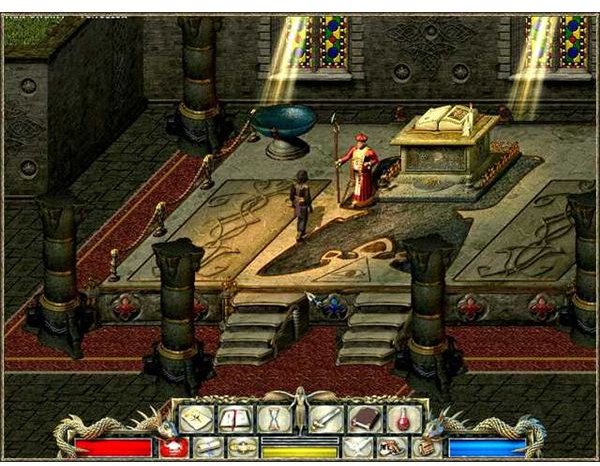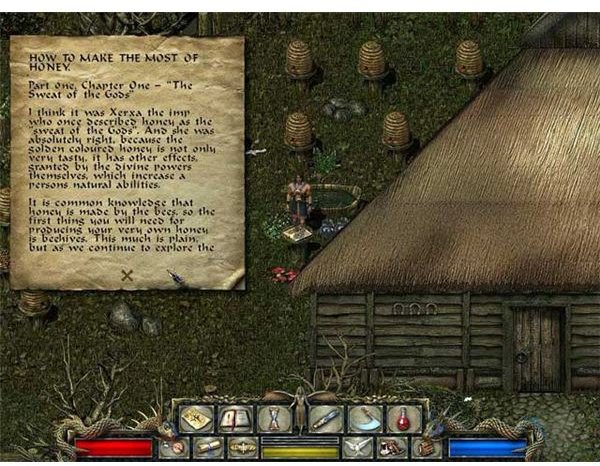Divine Divinity: Game Review for Windows PC

Introduction
The RPG part of the game is very simple: in the beginning every character can pick up one of the three classes, and his development in the game consists of distributing his attribute points in the related talent trees. You can make an analogy with Diablo here. However, no matter that the game mechanics are very similar, Divine Divinity has a completely different gameplay. In this game, killing monsters and gaining powerful items is not your only goal. Players should also enjoy the deep story and the numerous dialogues.
I won’t bother you to describe the world of Divine Divinity; it’s pretty much standard. Pick up a handful of orcs, dwarfs and elfs, add some dragons and gods – there you go. I don’t want you to think, however, that the game is boring. Quite the contrary; the game has a very interesting story that will you from the beginning, as well as some lighthearted and humorous moments.
Warrior, Sorcerer, and Thief
I doubt that you haven’t heard of this trio before. This is the most standard pack of fantasy heroes, used in many games since the time of Quest for Glory. In Divine Divinity, the first choice is also limited to these three classes. The authors tried to mask the trio by changing the name of the Thief into Survivor, but it doesn’t really makes sense though – it’s still a Thief! Additionally, you can chose between the two genders, thus leaving you with 6 picks.
Fortunately, you will have the possibility to individualize your hero by increasing different attributes, equipping different armor and choosing one of the 96 unique abilities useful in combat and out of it. These abilities are of course spread between the three classes. So we have three major classes and four sub-major talent specs. You can combine the talent specs; for example you can have a warrior that also uses the power of magic or the trickery of the thief. This way you can create a variety of heroes. Suddenly these three classes are much less boring than they appear at first glance.
Interactive World
Probably the most remarkable feature of Divine Divinity is the interactivity with the surrounding world. Nearly every object can be moved or destroyed, and even the biggest rocks are not a problem if your hero is strong enough. You can combine and experiment with different items that you find here and there. If you have alchemy, for example, you can make special elixirs by mixing specific ingredients. The problem is that you have to discover the recipes by yourself, unless you find a big book somewhere in the game. Clicking on a torch or candle will control its fire. All these actions are released through a very intuitive interface – you just need a few minutes to tune yourself to it.
I can just say a warm “bravo” to the game designers. Many good ideas are integrated in the game, but I don’t want to ruin your fun before you’ve tried the game.
I can’t, however, say many good words about the art designers. The graphics are well known: rendered three dimensional objects into a flat two dimensional world. Some people will actually like this, but I believe it could have been better. The animations are not good, either. They would probably have looked great a few years before the release of the game, but by the time Divine Divinity was released they were very outdated.
Not much criticism can be sent toward the music and the sound effects; they are formidable. Many of the dialogs feature voices of real people, and the quality is very good.
Help! Bugs!

If the art designers were not so great, then the beta testers just deserve to be killed. Besides the small graphic imperfections, the game would be nearly perfect if there were not dozens of bugs. It seems every company’s first role-playing game always has lots of bugs.
In addition to the classical in-game bugs, such as transparent walls or inaccessible items, there are quite dangerous coding errors that lead to crashing the computer. If your desktop is set to 32 bit color, for example, the game will crash every few minutes. Divine Divinity itself uses 16 bit color depth. You will also be upset if the game crashes when you are about to make a sav – and believe me, this happens quite a lot! Unfortunately, such shortcomings ruin the overall game impression. Thankfully, there was a patch of course that removed most of the bugs that we found in the original.
Conclusion
Besides all the cons, Divine Divinity is still a great game that I strongly recommend to every RPG fan. One last bit of advice: don’t kill the pigs of the angry dwarf after you have destroyed his grandfather’s remains. It’s just not nice.
